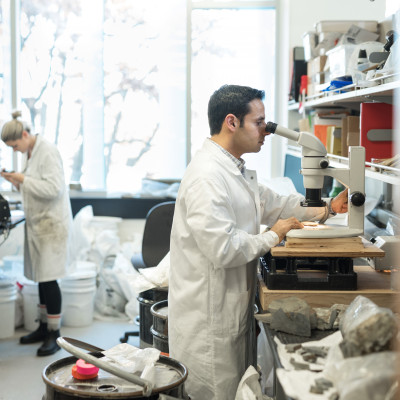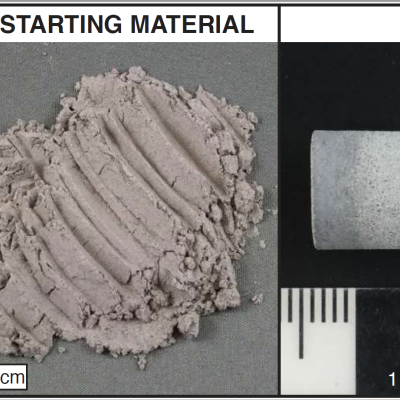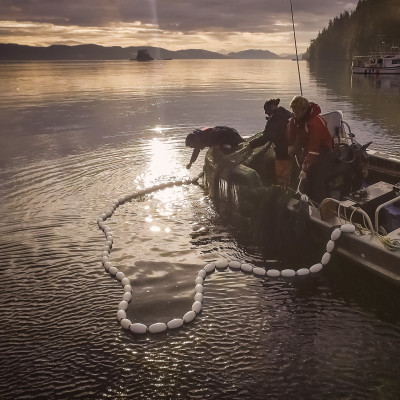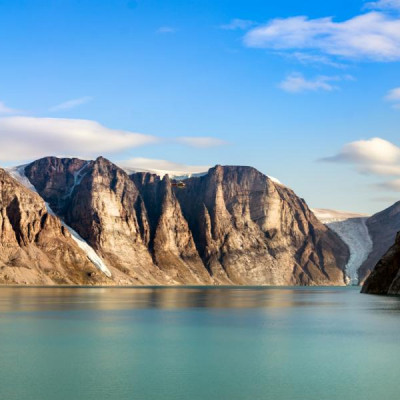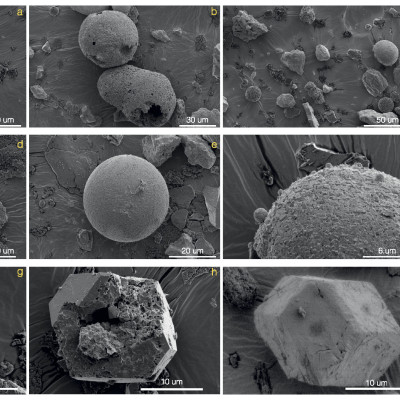News
Stay up-to-date with what's happening in EOAS
Whodunit?: A new forensic tool in the geodetective’s belt
Joel Saylor and Kurt Sundell
Creating a green economy requires increasing amounts of metals to support electrical generation, transport, and storage. However, new sources of metal and other economically valuable resources are increasingly difficult to find. Information about the location of economic resources is stored in sediments and sedimentary rocks that are eroded from the rocks that originally contained those resources. New research by Joel Saylor and Kurt Sundell develops a method of extracting information about the eroded rocks from the sediments themselves, even if the original rocks are unknown or unavailable for analysis. The new method, called non-negative matrix factorization, can identify specific chemical or isotopic features of the original rocks, as well as identifying the relative amounts of different source rocks that might have been mixed into a specific sediment sample. This new tool can guide exploration by identifying regions that have a high proportion of the economically relevant rocks and so help geoscientists zero in on potential areas for future mines.
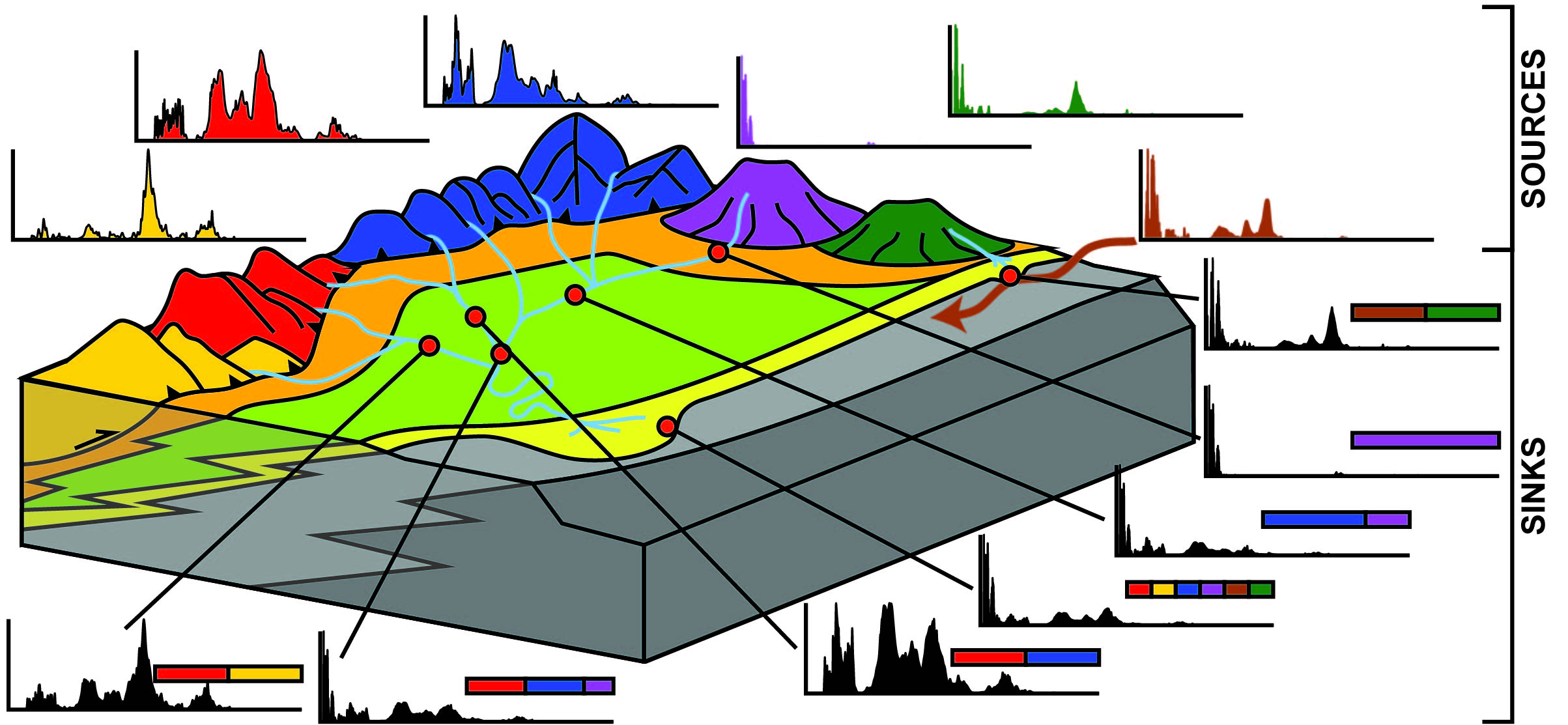
Saylor and Sundell's research provides a tool that links sources of sediment (colored mountains and associated curves) containing economically valuable resources to the sediments eroded from them (red dots and associated black curves).
Solid State Sintering Regulates Volcanism
Amy G. Ryan, James K. Russell, Michael J. Heap, Mark E. Zimmerman, and Fabian B. Wadsworth
Whether volcanoes will erupt explosively depends on the behavior of gases trapped in the subsurface. If gas pressures are high within a volcano, the surrounding magma and rocks can break, causing explosive eruptions. Alternatively, if gases vent to the surface through interconnected void spaces, explosive behavior does not occur. Void spaces in volcanoes are ephemeral – numerous processes can close them. Here we show that solid state sintering – a historically neglected process – operates pervasively and efficiently within volcanic conduits. We use high-temperature-pressure experiments and models to characterize and understand the timescales of this process under typical volcanic conditions. Our resarch shows the timescales (days to weeks) to be commensurate with the periodicity of explosive eruptions during lava dome producing eruptions.
New biogeochemical model reveals role of tides in shaping northern Strait of Georgia ecosystem
Elise M. Olson, Susan E. Allen, Vy Do, Michael Dunphy, and Debby Ianson
The University of British Columbia sits on a promontory overlooking the Salish Sea. As you look out over the water, you see its quickly changing variations in color and roughness. That is just the surface! We have run a model (SalishSeaCast: salishsea.eos.ubc.ca) every day since 2014 to capture the motion of the water, the mixing, and the changes in temperature and salinity. Now we have added a biological component so we can see changes in the phytoplankton growth as the phytoplankton blooms in the spring, then dies back due to nutrient limitation and grazing by zooplankton. Events, like wind storms, that resupply nutrients to the sunlit surface waters, can trigger new phytoplankton growth during summer months. In the manuscript, we present the model and its evaluation showing how accurately it represents this seasonal cycle and variability in time and space. We show that strong tidal flow through the narrow Discovery Passage, near Campbell River, leads to turbulent mixing, bringing deep nutrients to the surface. Tidal currents carry these nutrient-rich surface waters into the northern Strait of Georgia, relieving nutrient limitation and allowing phytoplankton to grow, contributing to the region's fish and shellfish productivity.
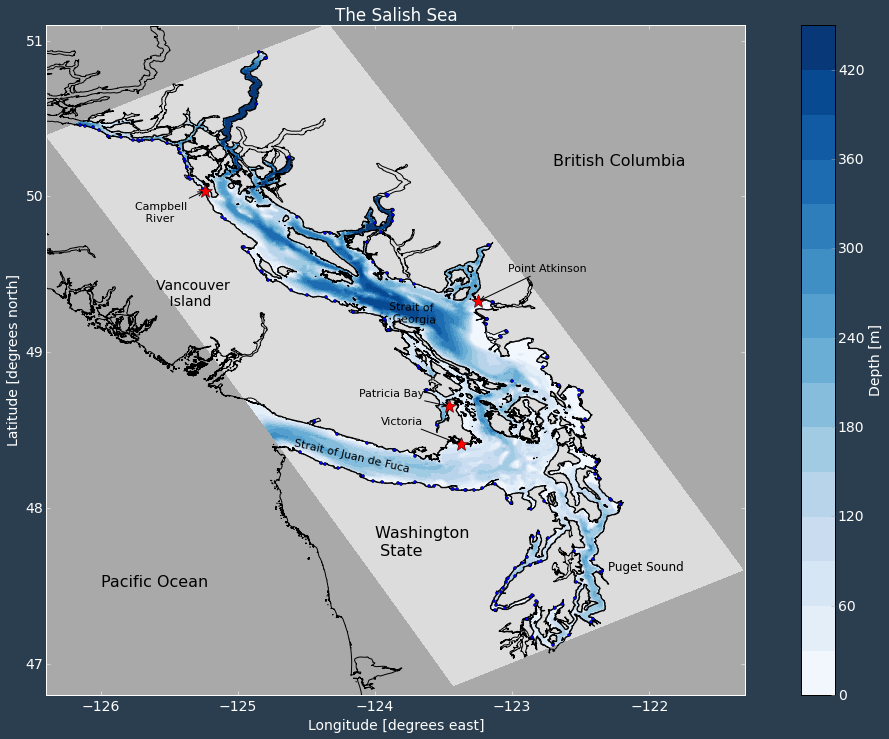
Strong tidal flow through the narrow Discovery Passage, near Campbell River, leads to turbulent mixing, bringing deep nutrients to the surface. Tidal currents carry these nutrient-rich surface waters into the northern Strait of Georgia, relieving nutrient limitation and allowing phytoplankton to grow, contributing to the region's fish and shellfish productivity.
Quarantine Conversation with Manar Al Asad
Manar is a research scientist in the Department of Earth, Ocean & Atmospheric Sciences at the University of British Columbia. She is interested in understanding the evolution of different parts of the solar system and its constituents. Her research career started with studying the interactions between Mercury’s magnetic field and the solar wind, and continued through her involvement as a scientific collaborator and Deputy Instrument Scientist on the OSIRIS-REx mission, the first NASA mission to attempt to bring a pristine sample back to Earth from an asteroid. Manar will begin her Ph.D. at the University of Berkley in January 2020 where she will expand her knowledge of planetary evolution through the study of the motion of material throughout Earth. Her main focus will be the interactions between the core and mantle throughout Earth’s history.
Pacific Museum of Earth · Quarantine Conversation with Manar Al Asad - Planetary Scientist
Geologists find lost fragment of ancient continent in Canada’s North
Maya Kopylova, E Tso, F Ma, and D G Pearson
Sifting through diamond exploration samples from Baffin Island, Canadian scientists have identified a new remnant of the North Atlantic craton—an ancient part of Earth's continental crust.
A chance discovery by geologists poring over diamond exploration samples has led to a major scientific payoff.
Kimberlite rock samples are a mainstay of diamond exploration. Formed millions of years ago at depths of 150 to 400 kilometres, kimberlites are brought to the surface by geological and chemical forces. Sometimes, the igneous rocks carry diamonds embedded within them.
"With these samples we’re able to reconstruct the shapes of ancient continents based on deeper, mantle rocks.”
“For researchers, kimberlites are subterranean rockets that pick up passengers on their way to the surface,” explains University of British Columbia geologist Maya Kopylova. “The passengers are solid chunks of wall rocks that carry a wealth of details on conditions far beneath the surface of our planet over time.”
But when Kopylova and colleagues began analyzing samples from a De Beers Chidliak Kimberlite Province property in southern Baffin Island, it became clear the wall rocks were very special. They bore a mineral signature that matched other portions of the North Atlantic craton—an ancient part of Earth's continental crust that stretches from Scotland to Labrador.
“The mineral composition of other portions of the North Atlantic craton is so unique there was no mistaking it,” says Kopylova, lead author of a new paper in the Journal of Petrology that outlines the findings. “It was easy to tie the pieces together. Adjacent ancient cratons in Northern Canada—in Northern Quebec, Northern Ontario and in Nunavut—have completely different mineralogies.”
Cratons are billion-year old, stable fragments of continental crust—continental nuclei that anchor and gather other continental blocks around them. Some of these nuclei are still present at the center of existing continental plates like the North American plate, but other ancient continents have split into smaller fragments and been re-arranged by a long history of plate movements.
“Finding these 'lost' pieces is like finding a missing piece of a puzzle,” says Kopylova. “The scientific puzzle of the ancient Earth can’t be complete without all of the pieces.”
The continental plate of the North Atlantic craton rifted into fragments 150 million years ago, and currently stretches from northern Scotland, through the southern part of Greenland and continues southwest into Labrador.
The newly identified fragment covers the diamond bearing Chidliak kimberlite province in southern Baffin Island. It adds roughly 10 percent to the known expanse of the North Atlantic craton.
This is the first time geologists have been able to piece parts of the puzzle together at such depth—so called mantle correlation. Previous reconstructions of the size and location of Earth’s plates have been based on relatively shallow rock samples in the crust, formed at depths of one to 10 kilometres.
"With these samples we’re able to reconstruct the shapes of ancient continents based on deeper, mantle rocks,” says Kopylova. “We can now understand and map not only the uppermost skinny layer of Earth that makes up one percent of the planet’s volume, but our knowledge is literally and symbolically deeper. We can put together 200-kilometre deep fragments and contrast them based on the details of the deep mineralogy.”
The samples from the Chidliak Kimberlite Province in southern Baffin Island were initially provided by Peregrine Diamonds, a junior exploration company. Peregrine was acquired by the international diamond exploration company and retailer De Beers in 2018. The drill cores sample themselves are very valuable, and expensive to retrieve.
“Our partner companies demonstrate a lot of goodwill by providing research samples to UBC, which enables fundamental research and the training of many grad students,” says Kopylova. “In turn, UBC research provides the company with information about the deep diamondiferous mantle that is central to mapping the part of the craton with the higher changes to support a successful diamond mine.”
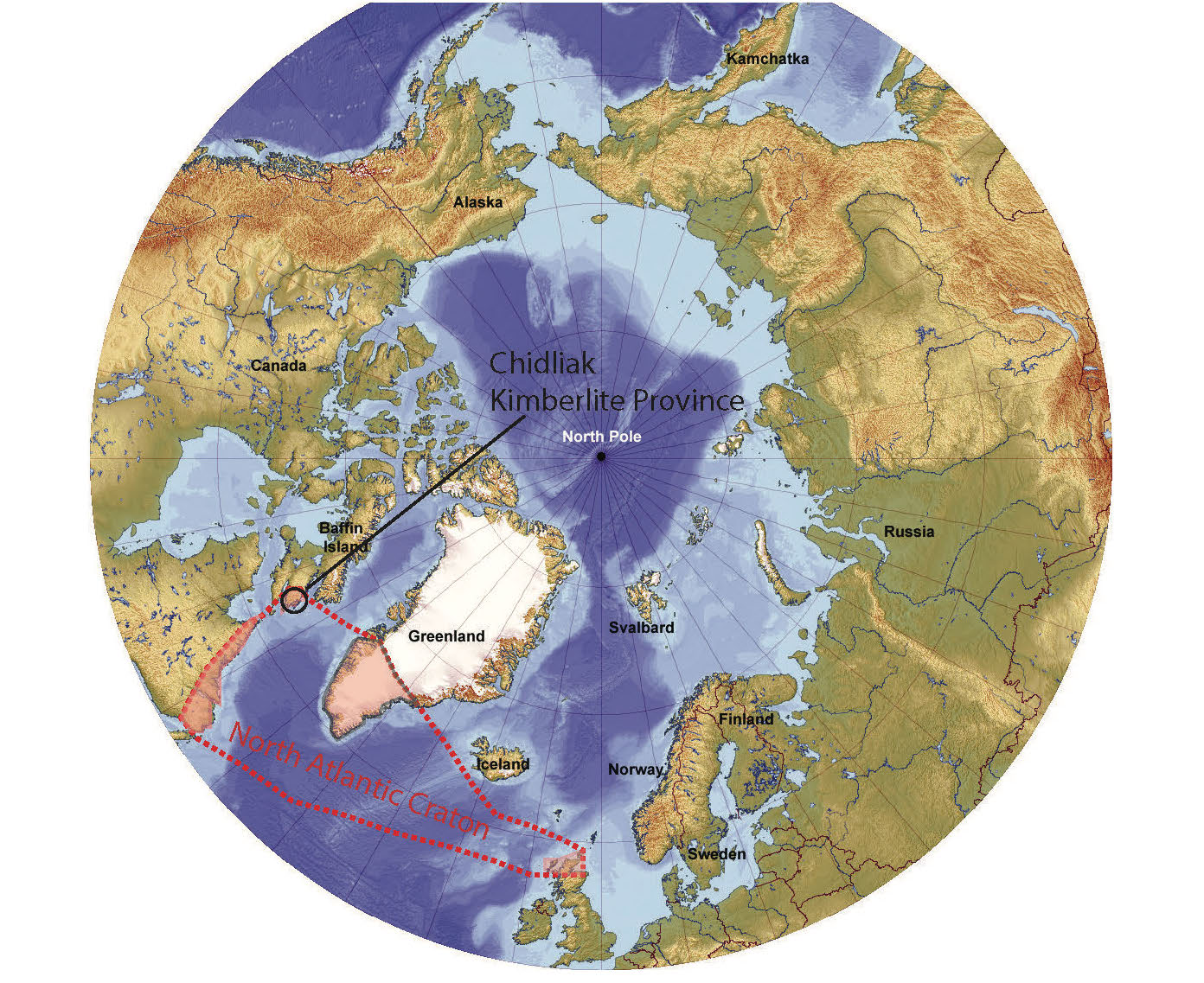
Magnetite biomineralization in ferruginous waters and early Earth evolution
Kohen Bauer, Matthijs Smit, Roger Francois, Sean Crowe, and co-authors
Evolution of Earth’s surface chemistry and biology are chronicled by minerals contained in rocks. For example, magnetite, an abundant iron mineral in Precambrian sedimentary iron formations (IFs), records the chemistry and biology of the ancient oceans and atmosphere. Mechanisms of magnetite deposition in IFs are uncertain, and thus so too are records of chemistry and biology in IFs. We find that magnetite forms unusual, raspberry-like, framboidal grains through microbial iron reduction in the waters of ancient ocean analogues, lakes Matano and Towuti (Indonesia). This magnetite is a major source of Fe to the underlying sediment, and the same mechanisms likely contributed to IF deposition. The conspicuous magnetite framboids may provide a biosignature on early Earth, Mars, and other planetary bodies.
